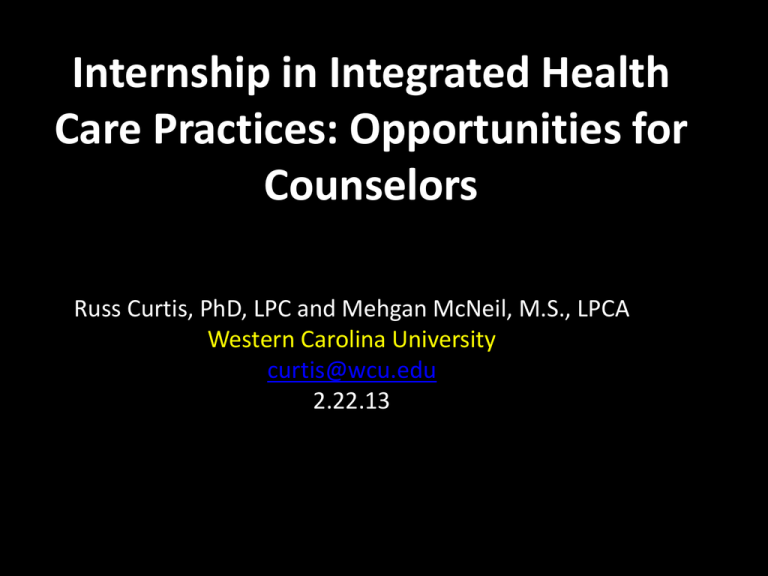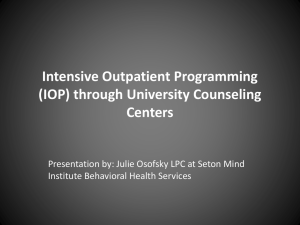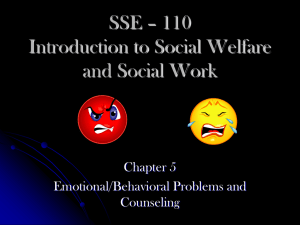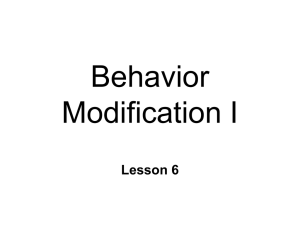Internship in Integrated Care - Powerpoint Presentation
advertisement

Internship in Integrated Health Care Practices: Opportunities for Counselors Russ Curtis, PhD, LPC and Mehgan McNeil, M.S., LPCA Western Carolina University curtis@wcu.edu 2.22.13 Table of Contents 1. 2. 3. 4. 5. 6. Integrated Care Defined Need for Integrated Care Supporting Research Training Integrated Care Professionals Internship in Integrated Care Resources Date Medical Procedure Cost (2004) 12-24-04 ER visit $1,178.37 Labs $150.00 Medical imaging $35.00 1-3-05 Follow up labs $133.00 1-7-05 Stress test $423.34 1-10-05 Pulmonary specialist $150.00 2-05 2nd Stress test $423.00 2-05 EEG #1 (approx.) $450.00 3-05 EEG #2 (approx.) $450.00 9-05 Trip to ER $1000.00 Total $4,392.71 Cost (2013) $6,143.68 Return on Investment of CBT for Anxiety CBT for Adult Anxiety Total Benefits Costs Net Benefit Odds of net present value $17,731 $341 $17,390 97% Lee et al. (2012) http://www.wsipp.wa.gov/pub.asp?doc id=12-04-1201 What IC can do • Further humanizes the medical culture • Reaches people who would otherwise never seek counseling • Gets closer to prevention • Quality relationships are good for our physical health My Experience with IC • MD: 60% of day was spent dealing with MH and SA issues • Mental health, psychiatrist, and pneumonia • WCU student and Dr. Nicholas Cummings • Psychiatrist asking me to check hospitalized client 1. Integrated Care Defined “Integrated care is the seamless and dynamic interaction of PCPs and BHPs working within one agency providing both counseling and traditional medical care services.” Curtis & Christian, 2012 Models of Integrated Care • Non-Targeted/Horizontal Integration • Provides a broad array of services to clients with various health related needs and concerns – Population focused • Examples: family medical practices, public health centers, Federally Qualified Health Centers (FQHC) Models continued • Targeted/Vertical Integration – Provides treatment for high risk clientele with specific concerns (i.e., diabetes, substance abusing pregnant women, cancer patients, & metabolic syndrome) – Example: Cancer Patient Support Program, Wake Forest University Medical Center Models cont. • Reverse Integration – Physical health physician working within mental health agencies to address the unmet physical heath needs of those with significant mental illness. – SPMI patients often neglect their physical healthy issues – ie. Metabolic Syndrome 2. Need for Integrated Care “Integrating services is increasingly recognized as important to achieving both the quality and cost-savings goals of health reform.” Kathleen Sebelius, 21st Secretary of the Department of Health and Human Sevices (in Butnett, CounselingToday, June 2012) • Only 40% of clients needing mental health services are identified by primary care physicians (PCPs). • Of the 40%, only 10% seek mental health treatment. • A significant percentage of elderly clients who committed suicide had visited their PCP within one month prior to their deaths (Conwell, 2001). Common clinical presentations don’t fit neatly within medical or MH boxes • 50% of all MH care is done by PCP’s. • 67% of all psychoactive drugs prescribed by PCP’s • Referral to MH/CD hard to navigate; often doesn’t connect. 50-90% follow-through Escobar et al, 2006 • Depression diminishes outcomes in medical conditions CJ Peek, PhD • Up to 70% of primary care visits have a psychological basis • Approximately 25% of patients in a primary care setting have a psychiatric disorder. • Only 3-5% of the population sees a mental health professional in any given year Robert Graham Center, “Why there must be room for mental health in the medical home; NBGH: An Employers’ Guide to Behavioral Health Services Frank deGruy (2010). Kentucky Policy Summit Common Medical Illnesses and Depression Multicondition 23% Seniors Major Depression 30-50% Stroke 15-20% 11-15% Heart Disease Diabetes Untreated Mental Health = More Healthcare Use • Depressed patients use 3 times more healthcare services • Depressed patients have 7 times more ED visits • Depression is associated with longer hospital stays • Only 50% diagnosed accurately in primary care • Of those started on antidepressant treatment by their PCP, only 40% recover by 4 to 6 months – Of those treated, < 1/2 receive recommended care Untreated MH = lost productivity • Absenteeism – Depressed workers miss work 2x as often as nondepressed workers • “Presenteeism” (reduced productivity while at work) – Depressed workers have 7x greater odds of decreased workplace effectiveness Druss et al. Am J Psychol, May, 2001 Associations of Mood Disorders with Work Performance Major Depressive Disorder − 27.2 lost work days per worker per year − US civilian labor force yielded 225 million lost work days (> $36 billion salary-equivalent productivity per year) • Bipolar Disorder − 65.5 lost work days per worker per year − US civilian labor force yielded 96.2 million lost work days (> $14 billion salary-equivalent productivity per year) Kessler, Akiskal, Ames, et al. Am J Psychiatry, 2006 Top 10 Health Conditions Driving Full Costs for Employers (Med + RX + Absenteeism + Presenteeism) Costs/1000 FTEs $400,000 $350,000 $300,000 $250,000 Presenteeism Absenteeism Drug Medical $200,000 $150,000 $100,000 $50,000 $0 Loeppke, R., et al., "Health and Productivity as a Business Strategy: A Multi-Employer Study“. JOEM. 2009;51(4):411428. Frank deGruy (2010). Kentucky Policy Summit Number of physical symptoms Frank deGruy (2010). Kentucky Policy Summit 3. Research PC is Preferred Location • 50-90% of referrals to BHPs outside of clinic setting did not result in therapy (Glenn 1987, Cummings 1990) • Depressed patients are more likely (91%) to accept care in primary care setting, which is significant when considering only 50% show up for first appointment with referral to an outside office (Katon 1995) Research: IC • Improving client and physician satisfaction with care (Kates, Crustolo, Farrar, & Nikolaou, 2001; Kenkel, Deleon, Mantel, & Steep, 2005) • More likely to receive counseling (Kessler, 2012) • Improving client outcome (Wang et al., 2007) • Reducing over health care costs (Katon et al., 2002). Adolescent Depression • Depressed adolescents in IC reported significantly less depressive symptoms, increased quality of life and were more satisfied with the care they received at the 6 month follow up compared to a treatment as usual group (Asarnow et al., 2005). Behavioral Issues • Children (5-12 years old) with behavioral problems demonstrated significant improvement among those treated in an integrated care practice compared to treatment as usual (Kolko, Campo, Kilbourne, & Kelleher, 2012). Decrease in Depression over time Month 1 Month 2 Month 3 Month 4 Month 5 Month 6 Month 7 Month 8 Months of Service 45 40 Increase in Mental Functioning over Time 35 30 25 20 15 10 5 0 Before Services Month 1 Month 2 Month 3 Month 4 Month 5 Month 6 Month 7 Month 8 Months of Service 80 Fewer missed work days in Past 3 Months Due to Emotional Reasons 70 60 Percentage 20 18 16 14 12 10 8 6 4 2 0 Before Services Average Score Average Score Buncombe County Health Center Integrated Care Project 50 40 30 20 10 0 Before Services Months 1-2 Months 3-4 Months of Service Months 5-6 Months 7+ 4. Training Integrated Care Professionals Training students IC Internship • Training Manual for Behavioral Health Interns • • • • • • Community Mental Health Contacts Electronic Medical Record (EMR) DSM-IV Criteria for most common mental health diagnosis Common Psychiatric medications rx’d by physicians Evidence-based therapeutic techniques Assessment instruments • Shadowing Behavioral Health Providers, Psychiatrist and Residents • Consultation, Intake, Psychotherapy sessions IC Core Competencies Strosahl (2005) 1. 2. 3. 4. 5. 6. Clinical Skills Practice Management Skills Consultation Skills Documentation Skills Team Performance Skills Administrative Skills 5. Internship in Integrated Care Typical IC Internship duties • • • • • • • • Conducting Clinical Evaluations Assessments Conduct Individual Psychotherapy Sessions Consult with Physicians and Residents Complete Case Notes Using EMR Provide Behavioral Health Consultations Case Management Attend BH Didactics Snapshot: An Integrated Care Program Nurse screens clients to establish care and annual appointments Physician sees client and validates screening Physician introduces client and counselor Physician and counselor provide team approach for coordinated care Behavioral Health Services integrated with Primary Health Care: • Screening • Assessment • Brief supportive counseling • Therapy • Case management • Medication monitoring • Coordinated team care PHQ -9 Depression Protocol 1. 2. 3. 4. 5. Medication Management PHQ-9 Self Care Action Plan Counseling? Appointment reminder Integrated Care for Depressed Patients Barrett & Landis, 2012 3 groups of patients: No consulting or CM (grp N); Consulting services but no CM (grp C); full IPC (consulting and CM-grp IPC) Grp N: 9/1/04 - 5/31/05 N=169 with PHQ9 of 10 or more Grp C: 1/1/09 - 10/8/09 N=350 Grp IPC: 1/1/10 - 2/5/10 N=33 Three Measures of PHQ9 Improvement, by Group (Barrett & Landis, 2012) Establishing IC Internship • • • • • • • LPCA billing, “Incident to the physician” Hospitals (possibly chaplaincy department) Pediatrics Federally Qualified Heath Centers (FQHC) University health centers Veteran Affairs Persistent and consistent 6. Resources Positive Psychotherapy in Integrated Care Class “It has often been pointed out that in healthcare it is 20 years after the proven effectiveness of a treatment before it is fully adopted. In this point of view, it will be 10 more years before integrated care is mainstream.” Cummings, O’Donohue, & Cummings, 2009 Resources Podcast, Video and Books: • Curtis, R., & Christian, E. (American Counseling Association). (2012, August). Integrated Care: Applying theory to practice [Audio podcast]. Retrieved from http://www.counseling.org/Counselors/TP/PodcastsHome/CT2.aspx • Curtis, R., & Christian, E. (Routledge). Integrated Care in Action [DVD]. Available from http://www.routledge.com/books/details/9780415891325/ also available from Alexander Street Press http://www.emicrotraining.com/product_info.php?cPath=22_82_116&products_id=539 • Blount, A. (Ed.). (1998). Integrated primary care. The future of medical and mental health collaboration. New York, NY: W. W. Norton. • Curtis R., & Christian, E. (Eds.). (2012). Integrated Care: Applying Theory to Practice. New York: Routledge. • O’Donohue, W. T., Byrd, M. R., Cummings, N. A., & Henderson, D. A. (Eds.). (2004). Behavioral integrative care. Treatments that work in the primary care setting. New York, NY: BrunnerRoutledge. • Patterson, J., Peek, C. J., Heinrich, R. L., Bischoff, R. J., & Scherger, J. (2002). Mental health professionals in medical settings. New York, NY: W. W. Norton & Company, Inc. • Robinson, P. J., & Reiter, J. T. (2006). Behavioral consultation and primary care: A guide to integrating services. New York, NY: Springer. Selected References • • • • • • • • • • • Aitken, J.B., & Curtis, R. (2004). Integrated health care: Improving client care while providing opportunities for mental health counselors. Journal of Mental Health Counseling, 26, 321-331. Conwell, Y. (2001). Suicide in later life: A review and recommendations for prevention. Suicide and Life Threatening Behavior, 31(Suppl), 32-47. Doherty, W. J., McDaniel, S. H., & Baird, M. A. (October, 1996). Five levels of primary care/behavioral healthcare collaboration. Behavioral Healthcare Tomorrow, 5(5) 25-28. Escobar, J. I., Gara, M. A., Diaz-Martinez, A. M., Interian, A., Warman, M., Allen, L. A., Woolfolk, R. L., Jahn, E., & Rodgers, D. (2007). Effectiveness of a time-limited cognitive behavior therapy-type intervention among primary care patients with medically unexplained symptoms. Annals of Family Medicine, 5(4), 328-335. Frank, R. G., McDaniel, S. H., Bray, J. H., & Heldring, M. (Eds.). (2004). Primary care psychology. Washington, DC: American Psychological Association. Kates, N., Crustolo, A., Farrar, S., & Nikolaou, L. (2001). Integrating mental health services into primary care: Lessons learnt. Families, Systems & Health, 19(1), 5-12. Katon, W., Russo, J., Von Korff, M., Lin, E., Simon, G., Bush, T., Ludman, E., & Walker, E. (2002). Long-term effects of a collaborative care intervention in persistently depressed primary care patients. Journal of General Internal Medicine, 17(10), 741-748. Mauer B. (2006). Behavioral health/primary care integration: the four quadrant model and evidence- based practices. Rockville, MD: National Council for Community Behavioral Healthcare. Mims, S., & Vinson, N. (2007, November). Dollars and sense: One community’s experience with integrated care services and costs data. Paper presented at the annual meeting of the Collaborative Family Healthcare Association, Asheville, NC. Rasmussen, N. H., Furst, J. W., Swenson-Dravis, D. M., Agerter, D. C., Smith, A. J., Baird, M. A., & Cha, S. S. (2006). Innovative reflecting interview: Effect on high-utilizing patients with medically unexplained symptoms. Disease Management, 9(6), 349359. Wang, P. S., Simon, G. E., Avorn, J., Azocar, F., Ludman, E. J., McCulloch, J., Petukhova, M. Z., & Kessler, R. C. (2007). Telephone screening, outreach, and care management for depressed workers and impact on clinical and work productivity outcomes. JAMA, 298(12), 1401-1411.








